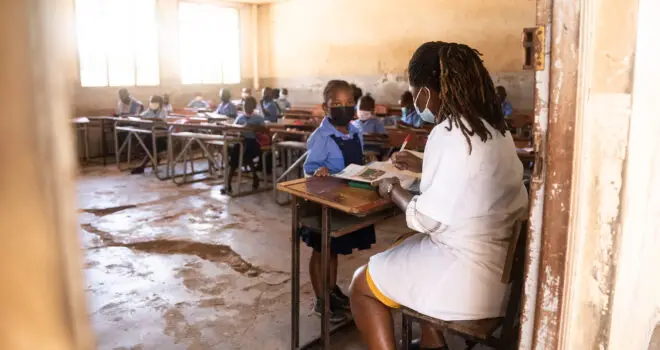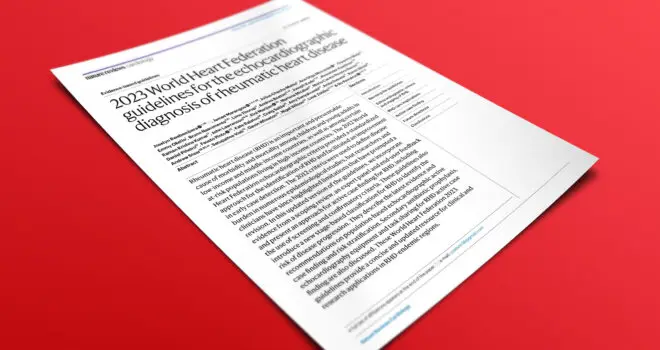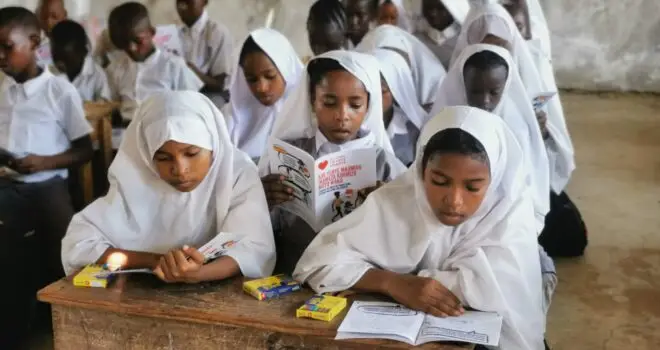A first of its kind study about the cost and benefit of investment in the prevention and management of Rheumatic Heart Disease (RHD) in the African Union was published today in the Lancet Global Health. The main finding is that mortality can be reduced by 30% over the next decade by investing USD 100 million annually in decentralizing and integrating cardiac care at rural primary care facilities and getting those with advanced disease on the right medicines and to cardiac surgery when needed. This means saving 70,000 lives.
The study looks at a set of interventions such as access to penicillin and access to cardiac care, and uses a model to estimate the health effects of scaling up these interventions over the next ten years in the PEN-Plus model for delivering care. The aim was to identify opportunities for cost-effective and high-impact reduction of RHD, a serious public health problem in poor countries, with African Union countries having the highest prevalence and incidence in the world.
Often referred to as the disease of extreme poverty, RHD is the most common heart disease in people under the age of 25. It begins as streptococcal throat infection and can progress to rheumatic fever and RHD, which may ultimately kill or incapacitate young adults and make pregnancy hazardous. Almost 40 million of the most vulnerable people live with RHD today; the disease claims 291,000 lives each year.
Against this backdrop, leading scientists, cardiologists, academics, and global organizations, such as the World Heart Federation, came together to develop this new modelling and propose concrete, economically, and medically sound measures which could reverse the tide in the next decade.
The study identifies two reasons for action: an opportunity to reduce RHD deaths by 30% through early detection, disease management, and cardiac surgery, with a very high return on investment (ROI) in the short-term; and an opportunity to reduce Rheumatic Fever incidence by 30% through strep throat treatment in primary care, with an attractive ROI over a longer-term.
“As someone who is living in Africa for 30 years, I am very aware of the continent’s numerous health care challenges, and the long wish list to tackle many life-threatening diseases. We must, therefore, prioritize and identify those actions which will have the biggest impact. In this modelling, we costed both primary care, and secondary and tertiary care interventions and found out that a much higher percentage of deaths can be avoided if we focus our efforts on secondary integrated care,” says Prof Karen Sliwa, WHF Past President, a renowned world cardiologist and co-author of the study.
The data must be carefully analyzed based on each country and region’s context and level of development, Prof Sliwa warns. There are countries such as Tunisia, which could afford investments in both primary and secondary care simultaneously because of its relatively small population size, higher rates of education, lower rates of RHD and more developed health care systems. For countries such as South Africa, the focus should be mostly on treating existing cases, and then there is Mozambique, a much poorer country, where RHD is still prevalent and where primary prevention should still be a priority.
While interventions to address and prevent and treat rheumatic fever, and Rheumatic Heart Disease have been known for quite a long time, this is the first study which looks at applying them in the hardest hit region, Africa. The focus of the paper is on monetizing them and asking the question: how many lives could be saved.
“We found an underrecognized opportunity in terms of investing in early detection of rheumatic fever and rheumatic heart disease, and providing cardiac surgery to those who need it. This strategy has a 5:1 return on investment in the short term, and will save around 70,000 lives by 2030, “says Gene Bukhman, one of the study’s authors and a cardiologist at Brigham and Women’s Hospital heading the Program in Global Noncommunicable Disease (NCDs) and Social Change at Harvard Medical School.
The WHO African Region is adopting PEN-Plus, one of the treatment management mechanisms put forward in this paper, as a regional strategy to combat RHD and other severe chronic noncommunicable diseases such as type 1 diabetes and sickle cell. The PEN-Plus strategy aims to integrate cardiac care at rural facilities and get those with advanced disease to cardiac surgery. Malawi, Liberia and Rwanda have already started to implement this strategy and an additional ten countries have indicated interest.
The Investment case for the prevention and management of rheumatic heart disease in the African Union 2021-2030: a modelling study, is the most recent outcome of years of campaigning and advocating from the RHD community, which culminated in the adoption of WHO Resolution on RHD in May 2018. As a next step, the authors’ costs and benefit scenarios should be used by leaders in health care to adapt the strategies based on their national and regional contexts.


